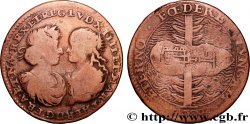Not available.
Item sold on our e-shop (2011)
Price : 380.00 €
Item sold on our e-shop (2011)
Price : 380.00 €
Type : Tétradrachme syro-phénicien
Date: 208-209
Mint name / Town : Laodicée, Syrie, Séleucie et Piérie
Metal : billon
Diameter : 26 mm
Orientation dies : 12 h.
Weight : 14,04 g.
Coments on the condition:
Infime usure, beaucoup de brillant de frappe, coins frais, style caractéristique du troisième groupe
Catalogue references :
Obverse
Obverse description : Tête laurée et drapée de Septime-Sévère à droite, l’un des deux rubans de la couronne laurée descendant sur l’épaule (A*01).
Obverse legend : .AUT. KAI. - SHOUHROS. .SE. (Autokrator Kaisaros Shvhros Sebastos)
Obverse translation : (L'empereur césar Sévère auguste).
Reverse
Reverse description : Aigle debout à droite, les ailes déployées, la tête et la queue tournées à gauche, couronne feuillée serrée dans le bec ; entre les pattes de l'aigle, sur une ligne de terre, une étoile à huit rais.
Reverse legend : DHMAR-C. EX. UPATOS. TOG. (Dhmarcikhs Exousias Upatos to G)
Reverse translation : (Puissance tribunitienne, consul pour la troisième fois).
Commentary
Les frappes du troisième groupe, plus que celles du second, ont de vrais motifs économiques et pour ce type clé de Septime Sévère, le Prieur 1149, la quantité d’exemplaires retrouvés démontre sans discussion une vraie fonction économique.
Pour reconnaitre les frappes du troisième groupe, trois indices, outre le style qui est franchement différent :
- les couronnes dans le bec de l’aigle sont à feuilles très serrées, presque comme une couronne d’épines
- la fin de la légende de revers voit le redoublement du TO
- les ailes de l’aigle sont asymétriques
L’identification de l’atelier est certaine grâce aux émissions de présentation qui montrent la Tyché de la ville assise sur un mont, un dieu-fleuve tenant le phare de la ville et nageant à ses pieds.
On note que les sigma sont gravés en C.
Dans la base TSP maintenue par Michel Prieur, cent trente exemplaires sont maintenant répertoriés. Notre exemplaire est le 1149_032.
The strikes of the third group, more than those of the second, have real economic motives and for this key type of Septimius Severus, the Prior 1149, the quantity of examples found demonstrates without discussion a real economic function. To recognize the strikes of the third group, three clues, besides the style which is frankly different: - the crowns in the eagle's beak are with very tight leaves, almost like a crown of thorns - the end of the reverse legend sees the doubling of the TO - the eagle's wings are asymmetrical The identification of the workshop is certain thanks to the presentation issues which show the Tyche of the city seated on a mountain, a river god holding the city's lighthouse and swimming at her feet. We note that the sigmas are engraved in C. In the TSP database maintained by Michel Prieur, one hundred and thirty examples are now listed. Our example is 1149_032
Pour reconnaitre les frappes du troisième groupe, trois indices, outre le style qui est franchement différent :
- les couronnes dans le bec de l’aigle sont à feuilles très serrées, presque comme une couronne d’épines
- la fin de la légende de revers voit le redoublement du TO
- les ailes de l’aigle sont asymétriques
L’identification de l’atelier est certaine grâce aux émissions de présentation qui montrent la Tyché de la ville assise sur un mont, un dieu-fleuve tenant le phare de la ville et nageant à ses pieds.
On note que les sigma sont gravés en C.
Dans la base TSP maintenue par Michel Prieur, cent trente exemplaires sont maintenant répertoriés. Notre exemplaire est le 1149_032.
The strikes of the third group, more than those of the second, have real economic motives and for this key type of Septimius Severus, the Prior 1149, the quantity of examples found demonstrates without discussion a real economic function. To recognize the strikes of the third group, three clues, besides the style which is frankly different: - the crowns in the eagle's beak are with very tight leaves, almost like a crown of thorns - the end of the reverse legend sees the doubling of the TO - the eagle's wings are asymmetrical The identification of the workshop is certain thanks to the presentation issues which show the Tyche of the city seated on a mountain, a river god holding the city's lighthouse and swimming at her feet. We note that the sigmas are engraved in C. In the TSP database maintained by Michel Prieur, one hundred and thirty examples are now listed. Our example is 1149_032








 Report a mistake
Report a mistake Print the page
Print the page Share my selection
Share my selection Ask a question
Ask a question Consign / sell
Consign / sell
 Full data
Full data















